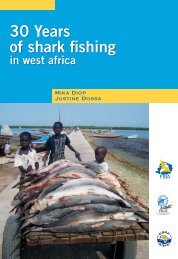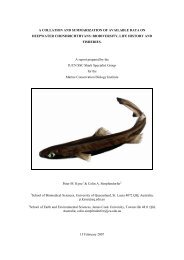Magazine of the species survival Commission specialist Group - IUCN
Magazine of the species survival Commission specialist Group - IUCN
Magazine of the species survival Commission specialist Group - IUCN
You also want an ePaper? Increase the reach of your titles
YUMPU automatically turns print PDFs into web optimized ePapers that Google loves.
editorial<br />
Lamproderma ovoideum. © Alain Michaud<br />
Fungi: <strong>the</strong> orphans <strong>of</strong> Rio<br />
Fighting for <strong>the</strong> future <strong>of</strong> fungi<br />
David Minter, Chair, <strong>IUCN</strong> SSC Cup Fungi, Truffles and <strong>the</strong>ir Allies Specialist <strong>Group</strong><br />
With biodiversity loss continuing at an unprecedented and<br />
frightening rate, <strong>the</strong> need for conservation action has never<br />
been higher. Hundreds <strong>of</strong> organizations around <strong>the</strong> world<br />
are dedicated to saving <strong>the</strong> world’s plants and animals, but<br />
what <strong>of</strong> <strong>the</strong> forgotten fungi? In this article, we examine <strong>the</strong><br />
need to raise awareness for fungus conservation, and take<br />
a look at how <strong>the</strong> <strong>IUCN</strong> Species Survival <strong>Commission</strong> (SSC)<br />
is planning on bringing this issue to <strong>the</strong> fore.<br />
It’s difficult to over-emphasize how important fungi are.<br />
Their wellbeing is necessary for sustainable life on this planet;<br />
without <strong>the</strong>m, we’re finished. To take just one example, <strong>the</strong>y<br />
are nature’s recyclers. Like <strong>the</strong> municipal refuse collectors<br />
employed to remove our rubbish, we don’t notice <strong>the</strong>m until<br />
for some reason <strong>the</strong>y stop. But – and it’s scary – stopping is<br />
something <strong>the</strong>y might just possibly do. Scientists have known<br />
for over 100 years that, like animals and plants, fungi too are<br />
affected by <strong>the</strong> destructive activities <strong>of</strong> mankind. There is<br />
already evidence that populations <strong>of</strong> many <strong>species</strong> are falling:<br />
<strong>the</strong> impact <strong>of</strong> air pollution on lichen-forming fungi is<br />
particularly well documented. Although <strong>the</strong>re is still<br />
insufficient information about <strong>the</strong> conservation status <strong>of</strong> fungi,<br />
<strong>the</strong>re is every reason to suppose that <strong>the</strong>y are just as<br />
vulnerable as o<strong>the</strong>r groups <strong>of</strong> organisms to habitat loss and<br />
climate change.<br />
Public awareness <strong>of</strong> <strong>the</strong>ir importance is, however, very<br />
low, not least because biodiversity – <strong>the</strong> full and wonderful<br />
diversity <strong>of</strong> life – is still widely portrayed as ‘flora and fauna’ or<br />
‘plants and animals’. Such misleading descriptions are <strong>of</strong>ten<br />
referred to, but biodiversity extends far beyond ‘plants and<br />
animals’ alone. The five kingdom classification <strong>of</strong> life, which<br />
recognizes fungi in a kingdom <strong>of</strong> <strong>the</strong>ir own, has been<br />
generally accepted by scientists since at least 1970 and, with<br />
an estimated 1.5 million <strong>species</strong> <strong>of</strong> fungi on this planet and a<br />
presence in all major ecosystems, freshwater, marine and<br />
terrestrial alike, this kingdom is megadiverse. There are far<br />
more fungi than all <strong>the</strong> plants and vertebrates put toge<strong>the</strong>r; to<br />
ignore <strong>the</strong>m is not a sensible option.<br />
The broader conservation movement, however, remains<br />
largely unaware <strong>of</strong> <strong>the</strong> need to conserve fungi. Priority<br />
habitats for conservation, such as biodiversity hotspots, are<br />
almost always defined on <strong>the</strong> basis <strong>of</strong> bird, mammal and<br />
flowering plant diversity. Fungi do not get a look-in, which<br />
means that habitats rich in fungal diversity are missed and<br />
remain unprotected. Most nature reserve management plans<br />
do not take fungi into account. Fungi are <strong>of</strong>ten treated as part<br />
<strong>of</strong> <strong>the</strong> problem, ra<strong>the</strong>r than recognized as <strong>the</strong>mselves being<br />
<strong>species</strong> 52 • 5
















